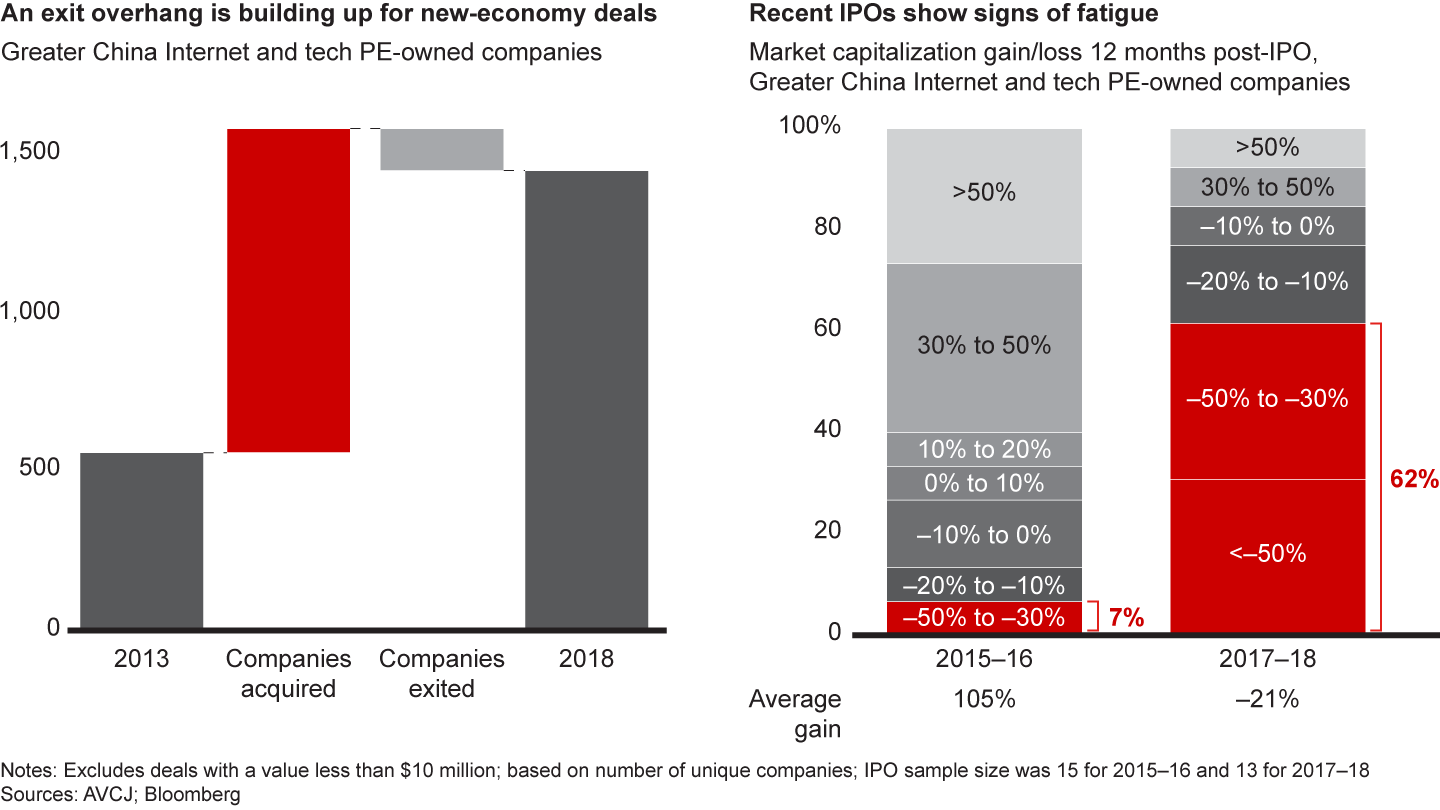Report

This article is part of Bain’s 2019 Global Private Equity Report. Explore the contents of the report here or download the PDF to read the full report.
Despite the overall slowing of China’s GDP growth, its new-economy sector has expanded dramatically over the past five years. Chinese Internet and technology firms are capturing a growing share of global private equity and venture investment, a signal of just how much has changed. In 2018, global investors poured an estimated $81 billion into Chinese start-ups—32% of invested global venture capital, up from 4% five years ago and creeping up on the 47% received by US start-ups (see Figure 1.12).


The US still produces more unicorns—start-ups valued at $1 billion or more—but Greater China is now producing them at a faster pace than the US. Internet and technology deals have accounted for roughly 85% of Greater China’s PE investment growth over the past eight years, and they represented fully half of all Asia-Pacific deal value in 2018.
As investors flock into the market, however, there are clear signs that China’s new economy may be overheating. With asset values soaring, we see potential for the speculative bubble to burst sooner rather than later. Fund managers who continue investing in Chinese Internet and tech companies do so now at considerable risk. Some may have the expertise to navigate the risks successfully, but for most investors, particularly those that haven’t yet entered the market, staying on the sidelines is likely the smartest short-term approach. Now’s the time to develop a clear strategy for the future by identifying where to strike opportunistically when valuations become more attractive. Given its long-term potential, China’s new economy will almost certainly bounce back from any crash.
A different world
By many measures, China’s new economy is in a class of its own. China’s consumers behave differently than Western consumers. Obsessed with technology and convenience, they snap up new products and online services quickly. Chinese Internet users surpass US users, for example, in adopting new apps for online entertainment, payments, and education and travel services. In the mobile payments industry, China racked up $9 trillion in transactions in 2016, 80 times the US level of $112 billion.
Cutthroat competition among the country’s burgeoning Internet and tech companies has shaped a Darwinian corporate culture. Managers expect their teams to deliver the rapid growth needed to survive. Employees in China’s tech sector work a grueling 72 hours per week on average—12 hours a day, six days a week. The pool of skilled labor is also deeper—China has almost six times more computer science graduates than the US. Overall, US computer scientists may be more skilled, but the profusion of engineering talent in China accelerates development.
Fueled by intense, open-source competition, Chinese tech companies also grow faster. While Silicon Valley companies have tended to steer clear of copycat products and services, Chinese managers consider it good corporate practice to copy the competition. Unlike their US counterparts, Chinese Internet and tech companies expand outside their core product or service in every direction. China’s Internet giants, for example, have acquired companies in financial services, gaming, education, healthcare and artificial intelligence.
Unsurprisingly, this dynamism has attracted a stampede of investors keen to tap into this large and growing market. According to Bain’s 2019 Asia-Pacific private equity survey, 80% of Greater China–focused funds are considering or actively pursuing new-economy deals. In 2017–18, more than 800 PE investors had a stake in an Internet or technology deal in China with a value greater than $10 million, up from about 170 in 2009–10. China’s new economy, once dominated by venture capitalists, now includes traditional private equity houses, LPs, sovereign wealth funds, and Internet giants such as Alibaba, Tencent and Baidu. The influx of investors has saturated the market for smaller deals and prompted many to focus on larger investments: Average deal size rose to $213 million in 2018, up from $30 million in 2013.

Get Our Latest Private Equity Insights
Receive Bain’s landmark Global Private Equity Report each February, plus the latest insights and developments in private equity throughout the year.
Early warning signs
For traditional PE investors, China’s new economy can be particularly challenging. Our research shows that 85% of PE investors focused on Greater China consider it difficult to evaluate new-economy companies, mainly because traditional PE valuation techniques don’t work in that market and because it’s difficult to justify investing in loss-making businesses.
At the moment, those risks are magnified by inflated expectations. Internet and technology deals already are wildly overpriced compared with other sectors. At 31 times EBITDA, median M&A deal multiples for Chinese Internet and tech companies are twice as high as those for other industries in Greater China, and 2.4 times greater than the median multiple for Asia-Pacific deals in 2016–18. That’s a warning signal for investors, and funds’ recent performance underscores the danger. China’s new-economy returns are in free fall: Median return multiples dropped to less than 2.0 times in 2016–18, from 4.7 times in 2014–15.
Another ominous sign: the sizable and expanding exit overhang of Internet and tech assets. Over the past five years, PE funds acquired more than 1,000 Internet and technology companies in Greater China with a value of $10 million or more, but they divested only about 130 in the same time frame. That trend means viable exit opportunities are scarce. Recent initial public offerings (IPOs) are a case in point. Companies that went public between 2017 and 2018 had lost, on average, 21% of their initial market capitalization 12 months post-IPO. And the losers lost big: 62% of companies that went public shed more than 30% of their value. By contrast, companies that went public between 2015 and 2016 gained an average of 105% in value in the first 12 months after the IPO. Only 7% lost more than 30% of their value. As the IPO market softens and return multiples drop, funds that overpaid for companies in their portfolios see no alternative but to hold onto assets (see Figure 1.13).


Given those challenges, it’s no surprise that GPs focused on Greater China are wary. A full 65% of those we surveyed see a high to very high risk of a bubble bursting in the coming years. Meanwhile, only 6% of them believe they are operating at full potential when it comes to establishing partnerships to help source new-economy deals. The same small proportion say they have a proven model to evaluate risks or add value in this sector.
Strategies for the future
Given the degree of uncertainty, the best strategy is likely to hold fire. There are plenty of solid investment opportunities outside China’s new economy, in markets that are not so overpriced. What is risky today, however, could well become attractive in the future, when soaring valuations retreat to a normal range. China’s new economy is moving at astonishing speed. Its entrepreneurs are creating a new paradigm for growth and value creation. That’s a wake-up call that fund managers should not ignore. Those who focus on defining a strategy now will be well positioned to seize opportunities, especially in a post-bubble market.
A few questions can help fund managers map out a clear approach for the future:
- What are the distinct capabilities that helped us win in the past, and which ones are transferable to new-economy markets in China?
- Under what conditions might it make sense to invest in Chinese tech or Internet companies in the future?
- If we decide to enter this market, where should we play first, and why?
- What are the capabilities or partnerships we would need? Which ones can be built or bought now?
This article is part of Bain’s 2019 Global Private Equity Report. Explore the contents of the report here or download the PDF to read the full report.